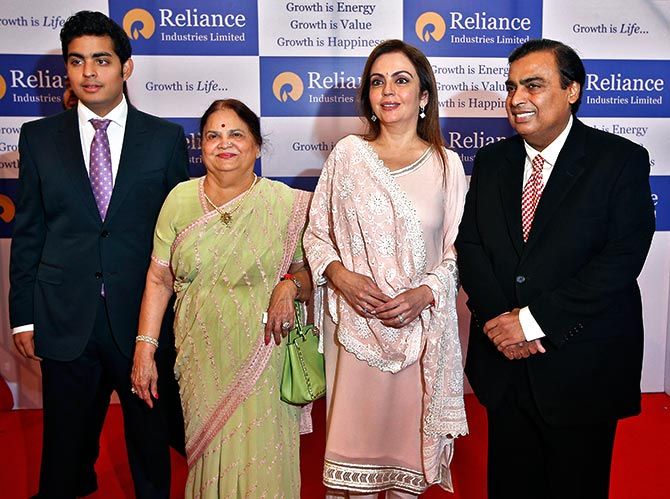Akash Ambani takes charge of a company that presents challenges but many opportunities, too.
Surajeet Das Gupta reports.

Akash Ambani’s first big job as he takes over as chairman of Reliance Jio, the group’s telecom arm, is a no-brainer — he has to get his company through the long-awaited 5G auctions that are a few weeks away.
But his bigger job, analysts said, will be to lead the transformation of the telecom company into a tech giant, a process that is underway as it seeks to list in the US.
Insiders said there has been plenty of debate within the company’s top executives on the auction strategy.
Now it seems the company will participate in the auction for 5G spectrum (they are expected to aim for 100 MHz).
The company is, meanwhile, reworking its business plans as a result of the government allowing captive private networks under the 5G policy, which came as a big dampener to telcos.
The big difference with the earlier auctions is that this time there is enough spectrum available in the 5G band for the three players (more so since Vodafone will only bid in select places).
Close watchers say Reliance Jio would aim to grab the “cleanest” spectrum in the 3.5 GHz band —between 3,500-3,600 MHz, where there is no interference from others and a huge ecosystem of supporting equipment and devices is available globally.
That would give it a big advantage over rivals. To do that, however, they have to be ranked number one based on a complex process of who has bid the highest in each session.
In bands between 3,400 and 3,500 Mhz, there are other users — such as the Indian Space Research Organisation (Isro), which runs its satellites, and the defence, which has equipment in coastal areas.
This reduces the amount of spectrum for telcos.
Getting spectrum is the easy part. But Akash Ambani, 30, will be at the helm for the first time, and will have to take such critical decisions on network planning and rollout as well.
Among the critical decisions here is choosing equipment vendors (Jio has tested a 5G network with Samsung), the speed at which it would like to roll out and in which circles or cities.
Beyond that, he will have to grapple with some challenges.
One is the lack of new-use cases for 5G currently, especially in the consumer space, though this is a work in progress even globally.
Another is the fact that the global experience of telcos has also not been too encouraging.
Those that have launched 5G services have seen stagnant average revenue per user, or ARPU, for many quarters despite huge fresh investments.
Third, permission for captive private networks, which would get spectrum directly from the government rather than through auctions, has virtually closed a lucrative revenue stream for telcos with 5G spectrum.
One popular global use-case of 5G is for providing the last-mile wireless link to homes that want high-speed broadband connectivity.
Unlike the fibre-to-the-home (FTTH) route, which needs right of way as roads have to be dug and fibre brought to the home, it is easier to roll out and scale up across the country.
But Ambani has a call to take, since Reliance Jio has pursued the FTTH route so far, saying it entails a one-time investment instead of the recurring costs of paying for spectrum.
Will he change tack to ensure a more aggressive rollout of broadband to home from a mere 30 million, which they have targeted currently?
So far Jio is in five million homes but competitor Airtel is catching up with 4.85 million homes.
Home broadband consumers offer ARPUs that are twice or three times higher than mobile broadband customers; if set-top boxes are added for media and entertainment, that number can rise even further.
However, 5G will certainly offer Ambani the opportunity to leverage Reliance Jio’s tech play, which Jio Platforms, the telco’s holding company that owns the group’s digital assets as well as Reliance Jio, has been working on and which he has been involved in (he is a director in Jio Platforms).
It will provide him the opportunity to complete the transformation of Reliance Jio from a telco to a tech behemoth with ambitions even globally.
The tech play has been built up through a combination of acquisitions, buying stakes in tech companies or in-house initiatives.
Now, the group needs to find opportunities to monetise these investments, which have been made not just in India but the US too.
For instance, Ambani and Reliance Jio’s team of engineers as well as US-based Radisys, which the group acquired, have been working on technology to launch standalone services, powered by a 5G “core”, or anchor of the network, that will control the networks and radio that have been built in-house.
Only a handful of networks have adopted this technology. 5G standalone technology is required to “slice” the network to provide customised services to an enterprise.
It enables very low latency services, such as remote surgery, precision machine-to-machine commands, automated cars and so on that rivals won’t be able to offer because their 5G networks are powered by a 4G core.
The other key area Ambani has to work on is to build new use-cases in 5G.
One such area that has been chosen is augmented and virtual reality and the whole immersive space.
To this end, Jio Platforms has bought start-up Tesseract, which has built JioGlass, a platform that enables both VR/AR with a myriad of uses, from watching movies, shopping (like JioMart), learning and gaming, thus opening up new areas of revenue generation.
In January, Reliance bought a stake in US-based artificial reality company Two Platforms, which is building immersive AI experience platforms.
And experts say with Meta, the Facebook parent, as an equity partner in Jio Platforms, a collaboration with them in the immersive space cannot be ruled out.
Most immediately, though, Ambani will also have to examine how to monetise Jio’s digital assets that currently are viewed by its captive subscriber base mostly for free — such as JioTV, JioNews, JioGames, MyJio amongst others.
JM Financial estimates the value of its digital assets at over $15 billion and reckons it leads other telcos in this race for similar monetisation.
The report said a huge subscriber base of over 470 million, plus a large number of apps on offer, increases customer stickiness and enables cross-selling of solutions.
In short, Ambani takes charge of a company that presents challenges but many opportunities, too.
| The new chairman’s 5G call |
|
Lead the company through the upcoming 5G spectrum auction Decide on network planning, vendors and the speed of roll out Deal with global shareholders in Jio Platforms to explain to them his strategy Sell its own 5G indigenous technology in the global market Help in monetisation of the group’s digital assets Work on new use cases for 5G, which will generate additional revenues Take a call on whether to continue the FTTH route for home broadband or supplement it with wireless last-mile broadband at homes and scale up faster Combat the challenge posed by the government permitting private captive networks by offering them spectrum directly, which would impact 5G revenue generation |












 © 2025
© 2025